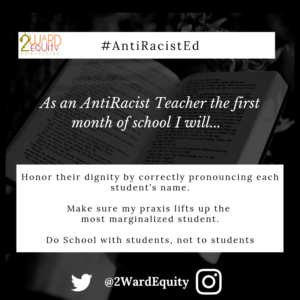Each year school starts across the country parents prepare their children for the daily learning ritual gathering supplies and planning for the shift from summer schedule to fall schedule. Teachers attend professional development and organize their classroom space. Principals scramble to hire for the last few positions, hoping they are fully staffed before the year launches.
This year needs to be different. Our schools are so much more complex and require educators, community members and corporate America to take note of the impact society has on the success of each student in public, private and charter school. I want to challenge each school governing board, central administration staff member, principal, business leader and community member to support the ability of the classroom teacher to begin this school year with an antiracist frame.
Why AntiRacist? As an educator of twenty-three years it is painfully obvious the racial impact of an educational system that was designed only for the most talented white males to succeed. This design has persisted since schools were staffed by white males to teach white males. Children come to school daily with the weight of anti-immigrant sentiment, ICE Raids, police violence against black men, F grades for low performing schools, and school communities holding tightly to mascots and names that promote and maintain racist ideals. An AntiRacist teacher recognizes the harmful impact of the weight of these societal issues on the families of all students regardless of race or color.
I challenge teachers to conduct your work with love and see the face of your loved ones on the faces of each student in your care. Consider your own children, your young relatives, your parents who were once children in someone’s classroom when you are making decisions for the loved ones of others. In your first month of school an AntiRacist teacher will:

1) Honor their dignity by correctly pronouncing each student’s name. Each time I engage adults in a discussion of their name, its origin and importance to their life I learn of adults who as children had their names changed. These adults never required teachers to pronounce their names correctly because their name, and therefore their identity, was not important enough. Teachers change names because they can’t pronounce them. Teachers change names because they have more than one student in the class with the same name. Teachers who teach hundreds of students and are AntiRacist make learning each student’s name a priority. Teachers who are AntiRacist recognize the powerful role they play in the positive identity development of each student in their care. Teachers who are AntiRacist honor the dignity in the given name of each child because they lead their classroom with love.
2) Make sure their praxis lifts up the most marginalized student. Recognize how your personal values, your worldview, your biases, and beliefs permeate your pedagogy and praxis and actively work to break down barriers to lift up the most marginalized student in your care. When I think about the students I’ve cared for over my years in the classroom I always centered my instruction on the top, middle and most marginalized. As an AntiRacist teacher I recognized that my pedagogical decision making had to focus on challenging my student who was developmentally delayed, black, emotional, gifted and not yet reading on grade level just as much as challenging my white, elite, book loving student.
3) Do School with students, not to students. When we think of traditional school each of us has a vision of what that looks, sounds and feels like. Traditional is not typically engaging, in many cases it looks like test prep where the classroom is devoid of community building, meaning making and students want to put their heads down with their hoodies over their heads in the middle of a lesson. I challenge teachers to shift slightly how you center your classroom on what you feel is traditional, comfortable and the way school should be done. An AntiRacist teacher, even the first week of school, creates space for students to co-create their learning, make meaning and build a positive, supportive classroom community.
